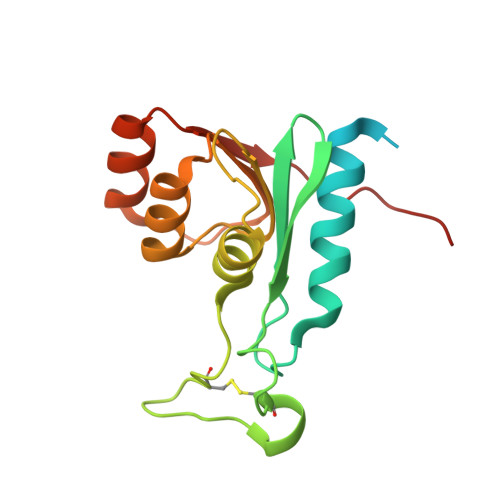Crystal structures of Streptococcus mutans 2'-deoxycytidylate deaminase and its complex with substrate analog and allosteric regulator dCTP x Mg2+.
Hou, H.F., Liang, Y.H., Li, L.F., Su, X.D., Dong, Y.H.(2008) J Mol Biol 377: 220-231
- PubMed: 18255096
- DOI: https://doi.org/10.1016/j.jmb.2007.12.064
- Primary Citation of Related Structures:
2HVV, 2HVW - PubMed Abstract:
2'-Deoxycytidylate deaminase [or deoxycytidine-5'-monophosphate (dCMP) deaminase, dCD] catalyzes the deamination of dCMP to deoxyuridine-5'-monophosphate to provide the main nucleotide substrate for thymidylate synthase, which is important in DNA synthesis. The activity of this homohexameric enzyme is allosterically regulated by deoxycytidine-5'-triphosphate (dCTP) as an activator and by deoxythymidine-5'-triphosphate as an inhibitor. In this article, we report the crystal structures of dCMP deaminase from Streptococcus mutans and its complex with dCTP and an intermediate analog at resolutions of 3.0 and 1.66 A. The protein forms a hexamer composed of subunits adopting a three-layer alpha/beta/alpha sandwich fold. The positive allosteric regulator dCTP mainly binds at the interface between two monomers in a molar ratio of 1:1 and rearranges the neighboring interaction networks. Structural comparisons and sequence alignments revealed that dCMP deaminase from Streptococcus mutans belongs to the cytidine deaminase superfamily, wherein the proteins exhibit a similar catalytic mechanism. In addition to the two conserved motifs involved in the binding of Zn(2+), a new conserved motif, (G(43)YNG(46)), related to the binding of dCTP was also identified. N-terminal Arg4, a key residue located between two monomers, binds strongly to the gamma phosphate group of dCTP. The regulation signal was transmitted by Arg4 from the allosteric site to the active site via modifications in the interactions at the interface where the substrate-binding pocket was involved and the relocations of Arg26, His65, Tyr120, and Arg121 to envelope the active site in order to stabilize substrate binding in the complex. Based on the enzyme-regulator complex structure observed in this study, we propose an allosteric mechanism for dCD regulation.
Organizational Affiliation:
Beijing Synchrotron Radiation Facility, Institute of High Energy Physics, Chinese Academy of Sciences, Beijing 100049, China.
















